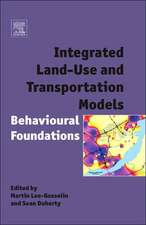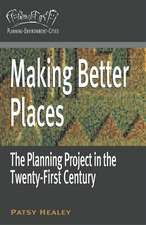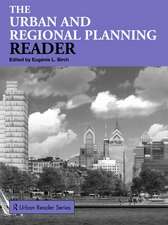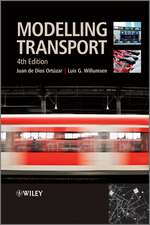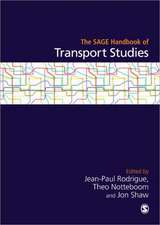Bus Transport: Economics, Policy and Planning: Research in Transportation Economics, cartea 18
Autor David A. Hensheren Limba Engleză Hardback – 29 ian 2007
| Toate formatele și edițiile | Preț | Express |
|---|---|---|
| Paperback (1) | 587.22 lei 5-7 săpt. | |
| ELSEVIER SCIENCE – 16 apr 2020 | 587.22 lei 5-7 săpt. | |
| Hardback (1) | 0.00 lei Indisponibil | |
| ELSEVIER SCIENCE – 29 ian 2007 | 0.00 lei Indisponibil |
Preț: 573.53 lei
Preț vechi: 744.85 lei
-23% Nou
Puncte Express: 860
Preț estimativ în valută:
109.80€ • 114.13$ • 91.03£
109.80€ • 114.13$ • 91.03£
Carte tipărită la comandă
Preluare comenzi: 021 569.72.76
Specificații
ISBN-13: 9780762314089
ISBN-10: 0762314087
Pagini: 538
Ilustrații: Approx. 110 illustrations
Dimensiuni: 152 x 229 x 43 mm
Greutate: 0.92 kg
Editura: ELSEVIER SCIENCE
Seria Research in Transportation Economics
ISBN-10: 0762314087
Pagini: 538
Ilustrații: Approx. 110 illustrations
Dimensiuni: 152 x 229 x 43 mm
Greutate: 0.92 kg
Editura: ELSEVIER SCIENCE
Seria Research in Transportation Economics
Public țintă
Academics and researchers in city planning, transportation, economics, and the social sciencesCuprins
Chapter 1: Introduction
Chapter 2: Organisation and ownership of public transport service
Chapter 3: User needs and impact on public transport
Chapter 4: Contracting options
Chapter 5: Contract areas and service quality issues in public transit provision: some thoughts on the european and australian context
Chapter 6: Performance-based quality contracts in bus service provision
Chapter 7: Performance-based quality contracts for the bus sector: Delivering social and commercial value for money
Chapter 8: Delivering value for money to government through efficient and effective public transit service continuity: Some thoughts
Chapter 9: Melbourne's Public Transport Franchising: Lessons for PPPs
Chapter 10: Establishing a Fare Elasticity Regime for Urban Passenger Transport
Chapter 11: Preserving the symmetry of estimated commuter travel elasticities
Chapter 12: TRESIS (Transport and Environmental Strategy Impact Simulator): A Case Study
Chapter 13: Productivity Measurement in the Urban Bus Sector
Chapter 14: A service quality index for area-wide contract performance assessment
Chapter 15: Developing a service quality index (SQI) in the provision of commercial bus contracts
Chapter 16: Non-commercial contract reimbursement: the institute of transport studies (ITS) model
Chapter 17: A bus-based transitway or light rail? Continuing the saga on choice versus blind commitment
Chapter 18: The future of exclusive busways: the Brazilian experience
Chapter 19: The imbalance between car and public transport use in urban Australia: why does it exist?
Chapter 20: Urban public transport delivery in Australia: issues and challenges in retaining and growing patronage
Chapter 21: Urban public transport agendas and challenges
References
Subject Index
Chapter 2: Organisation and ownership of public transport service
Chapter 3: User needs and impact on public transport
Chapter 4: Contracting options
Chapter 5: Contract areas and service quality issues in public transit provision: some thoughts on the european and australian context
Chapter 6: Performance-based quality contracts in bus service provision
Chapter 7: Performance-based quality contracts for the bus sector: Delivering social and commercial value for money
Chapter 8: Delivering value for money to government through efficient and effective public transit service continuity: Some thoughts
Chapter 9: Melbourne's Public Transport Franchising: Lessons for PPPs
Chapter 10: Establishing a Fare Elasticity Regime for Urban Passenger Transport
Chapter 11: Preserving the symmetry of estimated commuter travel elasticities
Chapter 12: TRESIS (Transport and Environmental Strategy Impact Simulator): A Case Study
Chapter 13: Productivity Measurement in the Urban Bus Sector
Chapter 14: A service quality index for area-wide contract performance assessment
Chapter 15: Developing a service quality index (SQI) in the provision of commercial bus contracts
Chapter 16: Non-commercial contract reimbursement: the institute of transport studies (ITS) model
Chapter 17: A bus-based transitway or light rail? Continuing the saga on choice versus blind commitment
Chapter 18: The future of exclusive busways: the Brazilian experience
Chapter 19: The imbalance between car and public transport use in urban Australia: why does it exist?
Chapter 20: Urban public transport delivery in Australia: issues and challenges in retaining and growing patronage
Chapter 21: Urban public transport agendas and challenges
References
Subject Index















